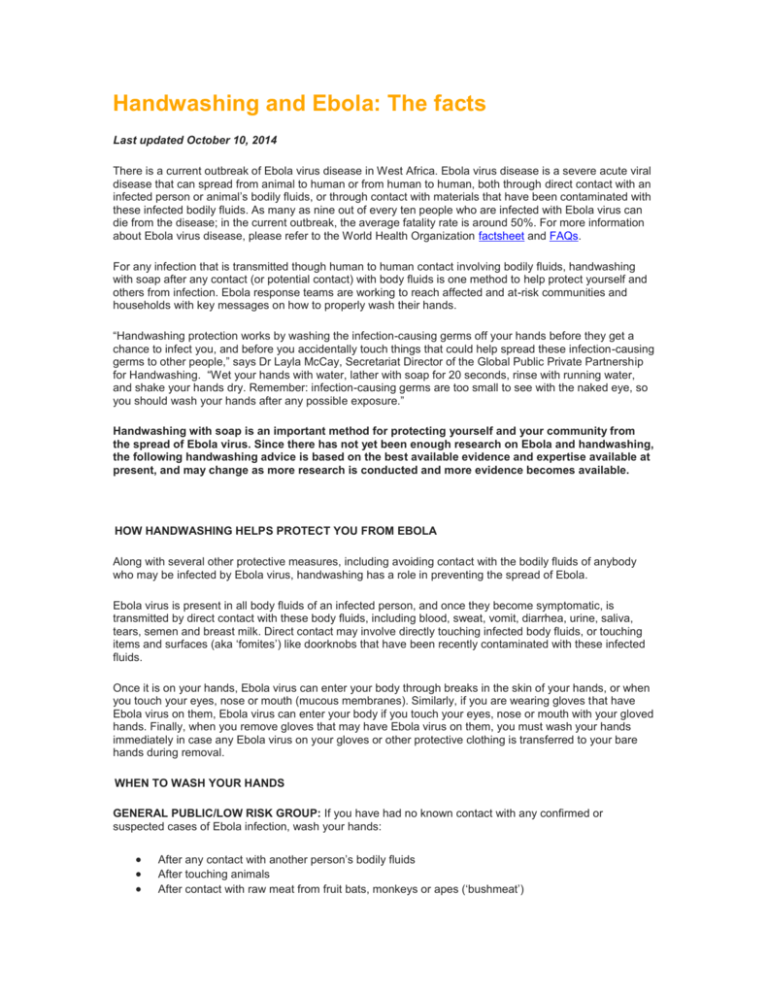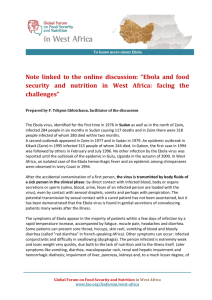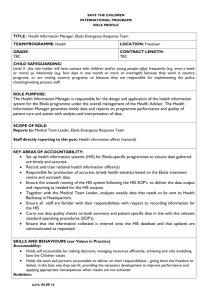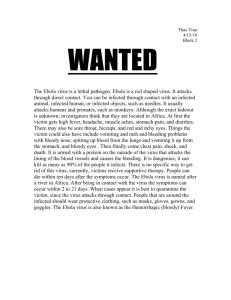The facts - Ebola Communication Network
advertisement

Handwashing and Ebola: The facts Last updated October 10, 2014 There is a current outbreak of Ebola virus disease in West Africa. Ebola virus disease is a severe acute viral disease that can spread from animal to human or from human to human, both through direct contact with an infected person or animal’s bodily fluids, or through contact with materials that have been contaminated with these infected bodily fluids. As many as nine out of every ten people who are infected with Ebola virus can die from the disease; in the current outbreak, the average fatality rate is around 50%. For more information about Ebola virus disease, please refer to the World Health Organization factsheet and FAQs. For any infection that is transmitted though human to human contact involving bodily fluids, handwashing with soap after any contact (or potential contact) with body fluids is one method to help protect yourself and others from infection. Ebola response teams are working to reach affected and at-risk communities and households with key messages on how to properly wash their hands. “Handwashing protection works by washing the infection-causing germs off your hands before they get a chance to infect you, and before you accidentally touch things that could help spread these infection-causing germs to other people,” says Dr Layla McCay, Secretariat Director of the Global Public Private Partnership for Handwashing. “Wet your hands with water, lather with soap for 20 seconds, rinse with running water, and shake your hands dry. Remember: infection-causing germs are too small to see with the naked eye, so you should wash your hands after any possible exposure.” Handwashing with soap is an important method for protecting yourself and your community from the spread of Ebola virus. Since there has not yet been enough research on Ebola and handwashing, the following handwashing advice is based on the best available evidence and expertise available at present, and may change as more research is conducted and more evidence becomes available. HOW HANDWASHING HELPS PROTECT YOU FROM EBOLA Along with several other protective measures, including avoiding contact with the bodily fluids of anybody who may be infected by Ebola virus, handwashing has a role in preventing the spread of Ebola. Ebola virus is present in all body fluids of an infected person, and once they become symptomatic, is transmitted by direct contact with these body fluids, including blood, sweat, vomit, diarrhea, urine, saliva, tears, semen and breast milk. Direct contact may involve directly touching infected body fluids, or touching items and surfaces (aka ‘fomites’) like doorknobs that have been recently contaminated with these infected fluids. Once it is on your hands, Ebola virus can enter your body through breaks in the skin of your hands, or when you touch your eyes, nose or mouth (mucous membranes). Similarly, if you are wearing gloves that have Ebola virus on them, Ebola virus can enter your body if you touch your eyes, nose or mouth with your gloved hands. Finally, when you remove gloves that may have Ebola virus on them, you must wash your hands immediately in case any Ebola virus on your gloves or other protective clothing is transferred to your bare hands during removal. WHEN TO WASH YOUR HANDS GENERAL PUBLIC/LOW RISK GROUP: If you have had no known contact with any confirmed or suspected cases of Ebola infection, wash your hands: After any contact with another person’s bodily fluids After touching animals After contact with raw meat from fruit bats, monkeys or apes (‘bushmeat’) Before preparing food Before eating food After using the toilet After changing a child’s diaper WHO guidelines for the general population are here. CONTACTS/HIGH RISK GROUP: If you have had contact or live with a confirmed or suspected case of Ebola infection: The above precautions, PLUS wash your hands: After visiting or caring for anyone with confirmed or suspected Ebola virus After any physical contact with anyone infected or potentially infected with Ebola virus After any physical contact with the clothes, bed linen, or other items or surfaces that could have been touched and contaminated by someone infected or potentially infected with Ebola virus If you have been wearing protective gloves, wash your hands immediately after removing them The World Health Organization recommends washing your hands with soap and running water immediately after visiting or taking care of people who are (or may be) infected with the Ebola virus. UNICEF recommends washing your hands with soap and a 0.05% chlorine solution. HEALTHCARE GROUP: If you work in health services in an at-risk area: The above precautions, PLUS wash your hands: After physical contact with each patient, regardless of whether they have been diagnosed with Ebola virus After touching or potentially touching any patient’s clothes, bed linen, waste, or other items or surfaces in the patient’s surroundings, regardless of whether they have been diagnosed with Ebola virus Before donning gloves and personal protective equipment (PPE) on entering an isolation area Before performing any clean or aseptic procedure on a patient After any exposure risk or actual exposure to a patient’s blood or bodily fluids After removing gloves and personal protective equipment (PPE) on exiting an isolation area Health workers are advised to practice good hand hygiene while treating all their patients, because the time interval from infection to onset of symptoms is from 2 to 21 days – so a diagnosis of Ebola is not always immediately apparent. WHO advises: It is important to note that neglecting to perform hand hygiene after removing PPE will reduce or negate any benefits of the PPE. Alcohol-based hand rubs should be made available at every point of care (at the entrance and within the isolation rooms and areas); running water, soap, and single use towels should also be always available. Soap and running water should always be used when hands are visibly soiled. Further information for healthcare staff is from WHO is available here. How long does Ebola virus survive outside the body, i.e. items and surfaces soiled by the body fluids of someone infected by Ebola virus? The CDC says the virus can survive on dry surfaces for several hours, and much longer in fluids. How long does Ebola virus persist in a person’s bodily fluids? When can I move to the low risk group for handwashing? While it can take up to two weeks from diagnosis for a person’s blood to be cleared of Ebola virus, it may persist for longer in other body fluids, for example there is evidence that it can persist in breast milk for up to 15 days, and in semen for up to 7 weeks. You should therefore continue washing your hands after contact with the body fluids, clothing, bed clothes and other fomites of a person convalescing from Ebola virus infection for at least two months after diagnosis to avoid the risk of becoming infected. HANDWASHING TECHNIQUE TO PREVENT EBOLA What should I use to wash my hands? We know that Ebola virus can be killed by: soap, chlorine, alcohol-based hand rub (CDC recommends at least 60% alcohol), very high heat, and exposure to many hours of sunlight. The preferred way to remove Ebola virus from your hands is with soap and running water. Soap and running water should always be used when hands are visibly dirty/soiled. If hands are not visibly dirty/soiled, you may alternatively use alcohol-based hand rub (at least 60% alcohol). Some organizations advocate the use of 0.05% chlorine solution in place of, or in addition to, running water as an added precaution. This is acceptable, but note: Chlorine should NOT be used as a replacement for soap or alcohol-based hand rub. Chlorine needs to be in contact with your hands for a prolonged period to have an effect on Ebola virus, typically much longer than it takes to wash your hands, so the added benefit in handwashing is not clear. The World Health Organization cautions that repeatedly washing your hands with chlorine solution can cause skin irritation and lesions, which can be counterproductive because broken skin creates a route for Ebola virus to enter the body. This risk increases as the chlorine solution becomes more concentrated. If you do use chlorine solution, it is important to ensure it is the right dilution (0.05%) and to check your hands regularly for signs of irritation: If chlorine causes irritation to your hands, you should stop using it. How should I wash my hands? You should wash your hands with soap in the usual way: 1. 2. 3. 4. Wet your hands with running water or 0.05% chlorine solution. Lather with soap for 20 seconds (the amount of time it takes to sing the ‘happy birthday’ song twice) – be sure to lather all parts of your hands: front, back and sides, and between fingers. Rinse your hands with running water or 0.05% chlorine. Shake your hands dry If you are using alcohol-based hand rub, you should apply a palmful of alcohol-based hand rub and use a similar technique as above to cover all parts of your hands, and then air dry. Here is the World Health Organization’s instructions for both types of hand hygiene. What should I do with the water I used to wash my hands? There is a theoretical risk that after using water to wash Ebola virus from your hands, the virus may persist in that water for some time. While there is no definitive or quantitative evidence of this risk, as a precaution, if you are washing your hands after contact with a confirmed or suspected person infected with the Ebola virus, you should dispose of this waste water in a way that does not expose yourself or others to potential infection, for example if your handwashing facility does not have effective water drainage, consider adding extra chlorine to the waste water, or disposing of it in a pit. How should I dry my hands after washing them? If you have washed your hands properly with soap, you should either air dry your hands, or dry them with a clean towel or paper as usual. Do not dry your hands on your clothes or on a dirty towel, as this risks recontamination with a wide range of germs.






